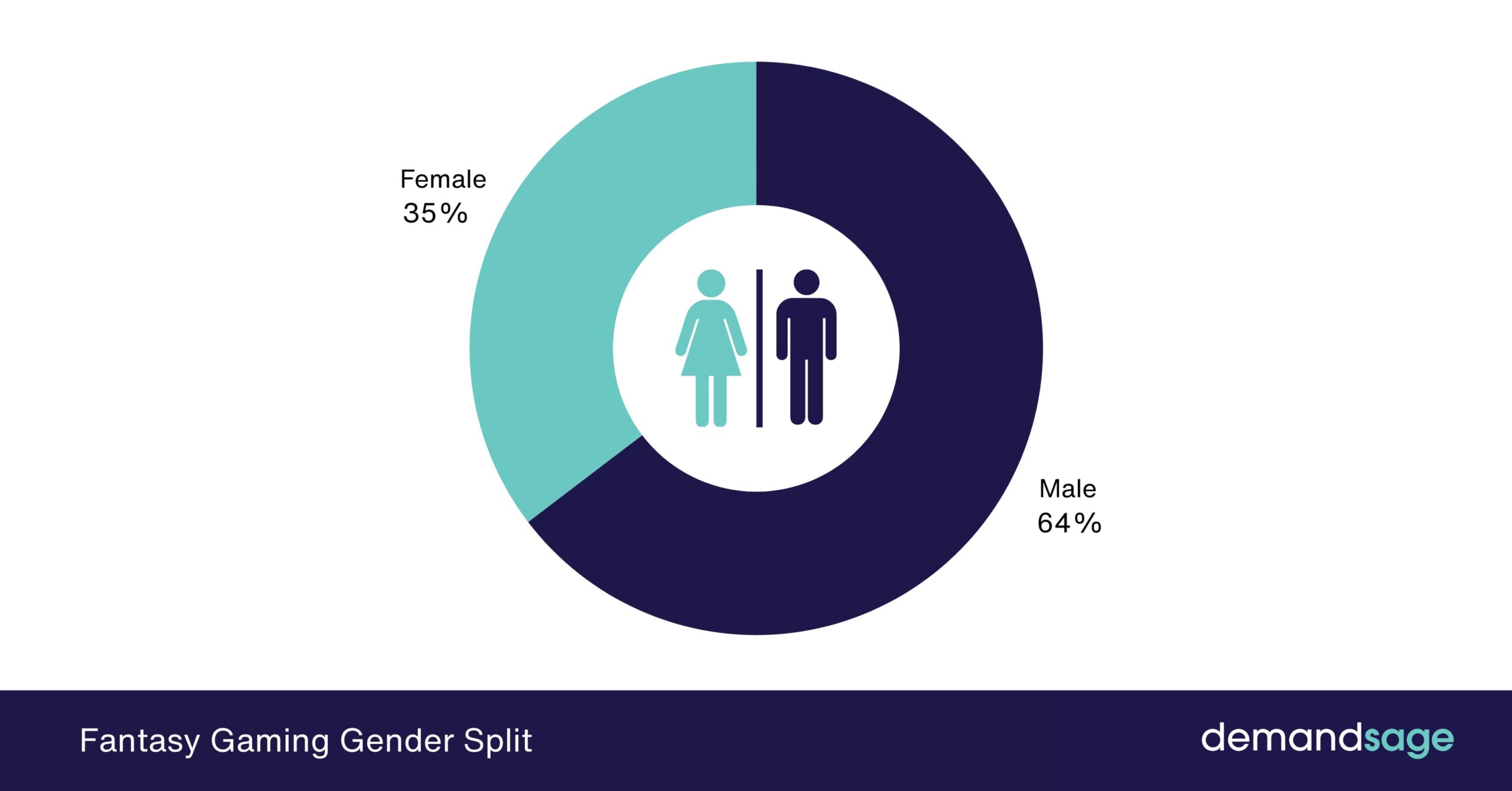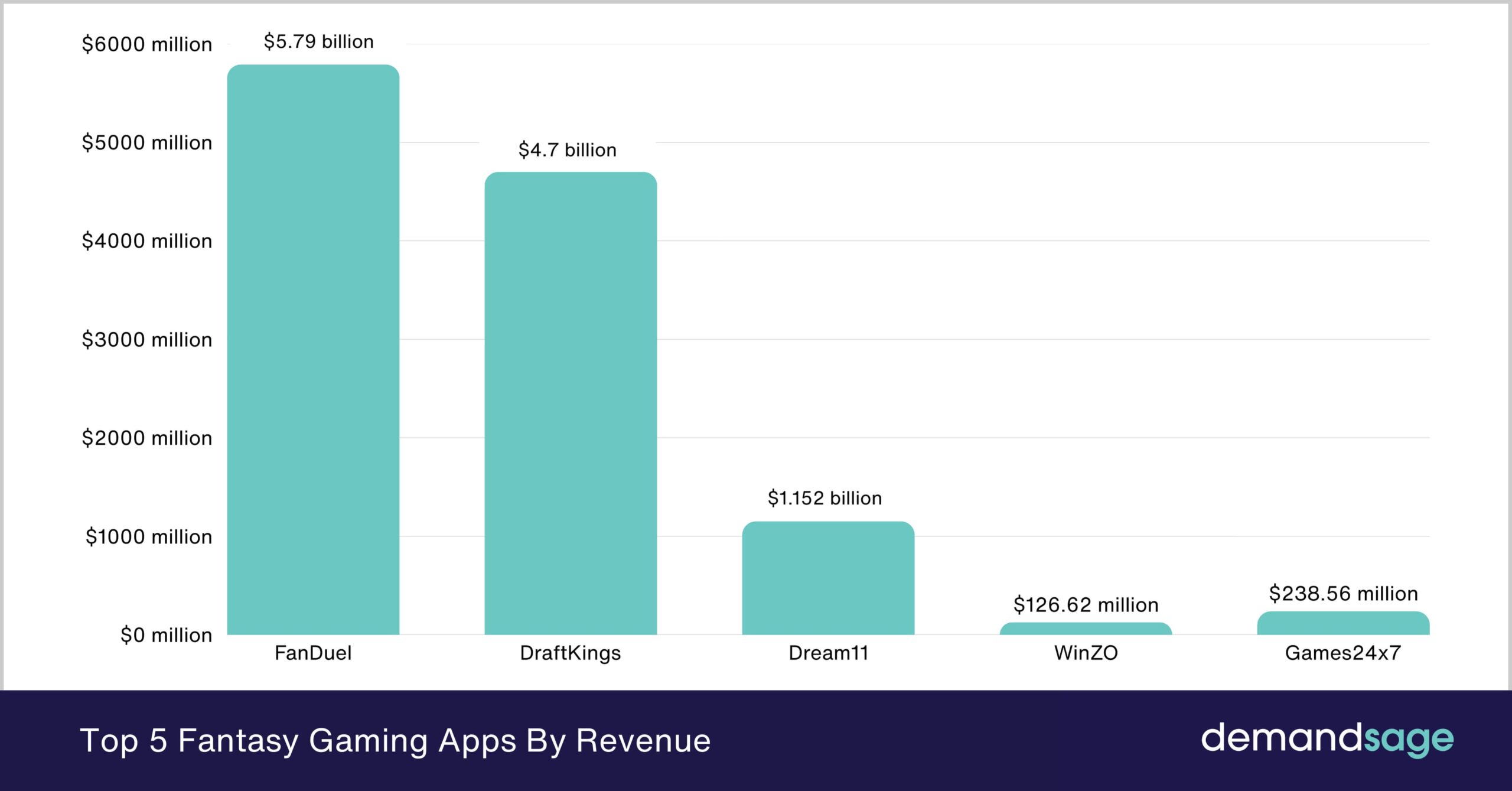The fantasy sports market is continuously growing on a global scale. The industry is projected to be valued at $31.13 billion by 2025. Projections indicate the market will reach $102.85 billion by 2034, representing a 14.2% compound annual growth rate.
Platforms like DraftKings and FanDuel change how fans follow sports; they also redefine how fans interact with the gaming area.
In the article ahead, we’ll look at the numbers behind this growth, who’s playing, the biggest platforms, and the trends shaping the future of fantasy gaming.
Fantasy Sports Market Size: Key Highlights
The global fantasy sports market is projected to hit $102.85 billion by 2034.
Male players dominate fantasy gaming with a 64% participation rate.
The US and Canada collectively had around 62.5 million fantasy sports players in 2022.
84 million adults in the U.S. and Canada joined fantasy sports or sports betting in the past year.
DraftKings generates $1.1 billion in revenue/quarter.
The United States fantasy football market was worth $13 billion in 2022.
How Big Is The Fantasy Sports Market? (Fantasy Sports Market Size)
The global fantasy sports market is valued at $31.13 billion in 2025 and is expected to reach $102.85 billion by 2034, with a 14.2% CAGR.
The fantasy sports market is projected to surpass $50 billion by 2029.
The table below gives an idea of the global Fantasy sports market size growth:
Sr. No.YearMarket Size12025$31.3 billion22026$35.55 billion32027$40.6 billion42028$46.37 billion52029$52.95 billion62030$60.47 billion72031$69.05 billion82032$78.86 billion92033$90.06 billion102034$102.85 billion
The US Fantasy Sports Market is expected to reach a projected revenue of $16,202.3 million by 2030, with a 13.1% CAGR.
Source: GVR 2, Expert Market Research
Fantasy Gaming Demographics
More than three-fourths (84%) of the fantasy sports players have a bachelor’s degree.
Almost two-thirds (63%) make more than $50,000.
The NFL is played by 74% of the fantasy players in the US.
Source: FSGA
Fantasy Gaming By Gender
The fantasy gaming sector is dominated by male players, making up 64% while females make up 35% of the player base.
The male-to-female player ratio in the fantasy gaming sector is approximately 1.83:1.
Sr. No.GenderPlayer Base %1Male64%2Female35%
Source: FSGA
Fantasy Gaming By Age
48% of fantasy sports players are between the ages of 18 and 34.
In India, three-fourths of fantasy sports users (75%) are younger than 35, according to 2023 data.
Source: FIFS 2023, FSGA
Fantasy Gaming By Country
The number of people playing fantasy sports in the USA and Canada has increased by 12,400% from 1988 (5,00,000) to 2022 (62.5 million).
Source: FSGA
United States Fantasy Gaming Market Trends
The US and Canada collectively have around 62.5 million people who participate in fantasy sports.
Among fantasy sports players, 81% also bet on sports in 2022.
Source: FSGA
The United States fantasy football market was valued at $13 billion in 2022.
Source: LinkedIn
Asia-Pacific Fantasy Gaming Market Trends
The Asia-Pacific market is projected to grow at a CAGR of 21.9% from 2025 to 2030.
Economies such as China and Indonesia are driving rapid growth due to increasing smartphone penetration rates.
European Fantasy Gaming Market Trends
The European online fantasy gaming market continues to grow as platforms allow users to join sports leagues. Users build virtual teams and compete based on the performance of real athletes.
As of 2024, the United Kingdom had 31.35 million gamers. This made it the largest gaming market in Europe.
France ranked second with 23.63 million gamers.
In 2023, Northern Europe recorded the highest internet penetration worldwide at 97.3% of the population.
Western Europe also follows closely, with an internet penetration rate of 93.7%.
Source: GVR
Fantasy Gaming Statistics
The average revenue of fantasy sports platforms in FY24 in India was ₹9,100 crore.
There are 677 Fantasy Sports Platforms startups as of 2025.
In 2019, the average user spent 42 minutes daily on fantasy apps.
Only 10% of users play fantasy sports twice a week or more.
A strong 91% of next-gen fantasy players expect they will continue playing next year.
Nearly 90% of young players plan to enter paid contests once they reach the eligible age.
Around 73% of players intend to participate in Daily Fantasy Sports (DFS).
About 74% of fantasy players expect to engage in sports betting once it becomes legally available to them.
Fantasy sports users spend an average of 175 minutes weekly watching and understanding sports.
In FY22, the fantasy sports industry contributed ₹3,100 crore to real-world sports through marketing and sponsorships.
84 million adults in the U.S. and Canada participated in fantasy sports or sports betting in the past 12 months.
In 2019, the typical user of a fantasy app was found to spend an average of 42 minutes per day on the platform.
Source: MRGE, Deloitte, FSGA 4, FIFS, FSGA 2, FIFS 2023, Tracxn
How Many People Play Fantasy Football?
The latest available data shows that 57 million players in the United States participated in fantasy football.
A large portion of fantasy sports participants in the United States, specifically 79%, play football.
Fantasy Premier League is projected to exceed 12 million players by the end of the current season.
NFL fans made up 17% of participants, while MLB fans accounted for 8%, and 7% played fantasy NHL.
Source: Business.you, FSGA 3, NAG, Attacking Football
Fantasy Sports Revenue Forecast
The global fantasy sports market is projected to reach $60.47 billion by 2030, as seen above.
Alternative projections indicate that the market will reach $105.58 billion by 2033, growing at a CAGR of 14.1% from a 2024 base of $32.21 billion.
Research and Markets estimates the fantasy sports market to grow to $59.63 billion by 2029 at a 14.9% CAGR from $34.23 billion in 2025.
Mordor Intelligence projects that the market will reach $71.24 billion by 2030, up from $37.28 billion in 2025, advancing at a 13.83% CAGR.
Source: Mordor Intelligence, Research and Markets, Straits Research, Expert Market Research
Top Fantasy Gaming Apps
Dream11 has 200 million registered users and reported a revenue of ₹6,384 crore (approximately $765 million) in the financial year 2023.
DraftKings has 32.4 million paid users each month, generating approximately $1.1 billion in revenue every quarter. The market value of DraftKings is $19.6 billion.
FanDuel has 12 million registered users. Flutter Entertainment owns FanDuel and has a market value of $42.0 billion.
ESPN Fantasy Football recorded more than 14 million people in the 2025 season.
Fantasy Premier League has 11.2 million players for the 2024-25 season.
Yahoo Fantasy Sports achieved record-breaking sales revenue in 2024, reaching an average of 115 million unique visitors per month
Here’s a list of the top 5 Fantasy Gaming Apps by their Revenue:
Sr. No.Fantasy Gaming AppAnnual RevenueYear1FanDuel$5.79 billion20242DraftKings$4.7 billion20243Dream11₹9,600 crore ($1.152 billion)FY244WinZO₹1,055.2 crore ($126.62 million)FY245Games24x7₹1,988 crore ($238.56 million)FY23
Source: MEF, Investopedia, Attacking Football, ESPN, Shortyawards, Covers, JPLoft, StoryBoard18, Business Standard, Entrackr
Market Share and Financial Performance
DraftKings reported 2.7 million monthly paying users as of early 2024.
DraftKings generated revenues exceeding $3.7 billion in FY2023.
During peak sporting events, such as the IPL, Dream11, My11Circle, and MPL collectively drive an estimated ₹3,000 crore ($360 million) in revenue.
Active user base exceeding 60 million during peak events.
DraftKings spent over $1.2 billion on marketing and sales in 2023.
Flutter (FanDuel’s parent) spent $3.78 billion in 2023 across all brands.
Source: Investopedia, MEF
Fantasy Gaming Apps: Future Outlook And Innovations
The AR/VR market in fantasy sports should grow from $727.44 million to $5,897.53 million from 2024 to 2032. The compound annual growth rate is 29.90%.
The global blockchain in gaming market is projected to reach $301.53 billion by 2030, showing the integration potential with fantasy sports.
The NFT gaming market was valued at $4.8 billion in 2024 and is projected to grow at a 24.8% CAGR through 2034, indicating opportunities for integrating fantasy sports.
5G technology enables latency reduction to 1 millisecond compared to 4G’s 50ms, crucial for real-time fantasy gaming experiences.
AI-driven personalization and real-time data analytics are becoming standard features, with platforms processing up to 44TB of data per day, like Dream11.
The Indian Parliament passed the Promotion and Regulation of Online Gaming Act, 2025. This act bans all real-money online gaming, which includes fantasy sports.
The once-bullish projections for the Indian fantasy sports market, which was estimated to be worth approximately USD 5 billion in 2023 and growing at a CAGR of 22.6% to reach USD 5.05 billion by 2030, are now obsolete.
The act promotes e-sports and social games, but it also enforces penalties, which include imprisonment and fines.
Additionally, in the UK, mandatory maximum stake limits for online slots games have been introduced, with a £5 per spin limit for players aged 25 and over and a more restrictive £2 per spin limit for those aged 18 to 24.
In the United States, regulation is not whole. State laws differ significantly, but federal proposals aim to address gaps in advertising, the use of AI, and consumer safety.
In Australia and like jurisdictions, authorities give games with gambling-like elements a new class; they block illegal sites and enforce stricter ad controls to keep minors safe.
Source: Clifford Chance, Kai Waehner, Knick Global, GM Insights, NAG, Credence Research, Mordor Intelligence




